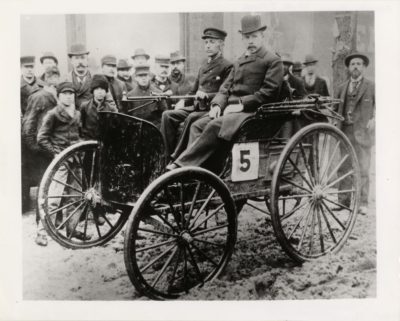
The winning car of the 1895 Chicago Times-Herald race, the Duryea Motorized Wagon, shown here on the occasion of the famous event. The Duryea car had a one-cylinder internal-combustion engine. Photographer unknown, Detroit Public Library Digital Collections
By Eric Bryan
Though Detroit is world-famous as the capital of American automobile production, when it comes to electric cars, Des Moines beat the Motor City to the punch. A Scottish immigrant who settled in Des Moines in 1880, William Morrison began as a chemist, but his main interest was in electricity, and specifically, batteries. Laboring in an obscure basement workshop below Lumbard Jewelry on Fifth Avenue between Locust Street and Grand Avenue, Morrison focused on the chemistry of electric storage batteries and sought to make a battery which was portable, yet powerful. By extension, Morrison’s battery experiments led the inventor to create the first successful American electric car in 1890.
Born circa 1850 and educated at a Scottish university, Morrison had a passion for inventing and had been fascinated with electricity since he was a boy. He was quiet and usually preferred to work in silence and solitude. Tall and clean-shaven with dark hair, Morrison was a hefty man and a vegetarian.
With jewelers Marquardt and Lumbard funding Morrison’s experiments, the inventor brainstormed with L. Schmidt on a new method of producing battery plates which insulated them and prevented them from shorting out. These efforts resulted in a lighter and more powerful battery.
Morrison’s first electric vehicle, made in 1887, consisted of a carriage manufactured by the Des Moines Buggy Company, equipped with Morrison’s new storage batteries and an electric motor to power the right rear wheel. This early model wasn’t a great success, but news of Morrison’s horseless carriage was reported by The Iowa State Register, then picked up by the Associated Press and soon thousands were reading about this Des Moines pioneer of electronics.
TO READ MORE ABOUT THIS STORY AND OTHER FASCINATING STORIES ABOUT IOWA HISTORY, subscribe to Iowa History Journal. You can also purchase back issues at the store.
